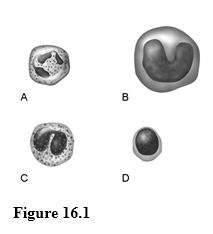Using Figure 16.1, match the following:

1) Monocyte.
2) Lymphocyte.
3) Eosinophil.
4) Neutrophil.
5) Most common white blood cell found in whole blood.
6) Mounts an immune response by direct cell attack or via antibodies.
7) Kills parasitic worms.
8) Becomes a macrophage.
9) Main bacteria killer during acute infections.
1) B
2) D
3) C
4) A
5) A
6) D
7) C
8) B
9) A
You might also like to view...
A ________ fracture shatters the bone
A) comminuted B) greenstick C) compression D) transverse E) spiral
The synapse of the olfactory nerves with the mitral cells is called a ________.
Fill in the blank(s) with the appropriate word(s).
The connective tissues that surround skeletal muscles are collectively called
A) deep fascia. B) aponeuroses. C) superficial fascia. D) subserous fascia. E) None of the answers are correct.
The digestive functions performed by saliva and salivary amylase respectively are ________.
A. peristalsis and polysaccharide digestion B. flushing and protein digestion C. moistening and starch digestion D. swallowing and lipid digestion E. None of the choices are correct.